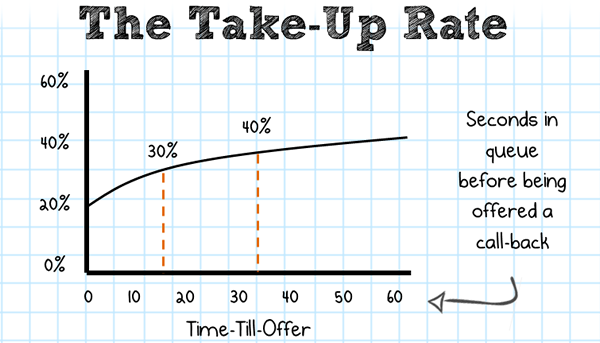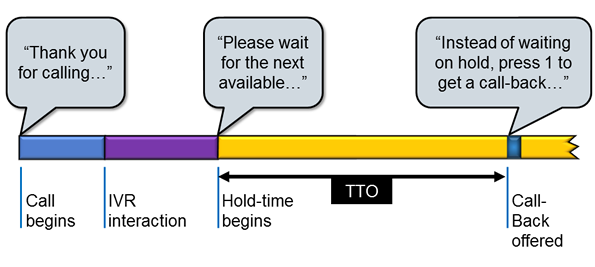Is your call center still forcing callers to wait on hold? If so, you are missing out on a great opportunity to increase customer satisfaction and reduce call center costs: Deploying a call-back solution.
The basic idea of call-backs (aka “virtual queuing”) has been part of the call center world for decades. But it’s becoming more popular because A) Consumers are less patient and more demanding (See onholdwith.com for proof); and B ) Adding call-backs no longer requires expensive, equipment-based solutions, but instead can be easily added via a cloud-based service (like Fonolo) that works on top of legacy call center platforms.
However, like any technology project, there are pitfalls to avoid. If you’re exploring the idea of adding call-backs, here are some do’s and don’ts to help you.
1) Do Offer Call-Backs at the Right Time in the Queuing Process
The call-back process begins when the caller hears an offer message, something like, “Instead of waiting on hold, you can get a call-back from the next available agent by pressing 1 now.” So when should that offer be presented? This is a key variable in every call-back deployment. It’s usually referred to as the “Time-Till-Offer” (TTO) and is defined as the amount of time a caller spends in queue before hearing a call-back offer.
Changing the TTO will impact how many callers hear the offer. For example, if the average hold time is 2 minutes, but the offer isn’t played until 3 minutes in the queue, most callers won’t hear it.
TTO also impacts the Take-Up Rate, which is the fraction of callers who opt-in after hearing the message. To understand the relationship between these two values, it helps to put yourself in the caller’s mindset: Some people will take an offer that is made immediately, while others will opt to “wait it out”. But after a few minutes on hold, callers are more likely to opt-in, so the Take-Up Rate grows. After a while, this effect flattens out. The chart below is an example of this relationship (but may differ in your situation).

For a real-world example, watch this short video of a Fonolo customer talking about adjusting the TTO in his call center:
Another way to increase the Take-Up Rate is to make multiple offers. This is actually the best way to maximize the overall call-back rate. (This is definitely an ability you want in you call-back solution.)
This was just a quick taste of the thinking that goes into the offer message. If you want to go deeper into this topic, a great resource is our eBook, “The ROI of Call-Backs for Your Call Center”. For now, just remember: Changing TTO is an easy “lever” to adjust and has a big impact on the performance of your call-back deployment.
2) Don’t Make Customers Wait a Second Time
When the caller’s turn has arrived at the front of the queue, it’s time for the call-back system to connect the agent and caller. There are two ways to handle this: “agent-wait” or “customer-wait”.
In the agent-wait scenario, the agent is already on the line when the customer answers the call. This is a better experience for the customer, but the agent has to wait while the customers phone rings. Luckily, the idle time is typically 10 seconds or less.
In the customer-wait scenario, the call-back system tries to estimate when the next agent is going to be ready, and calls the customer a few minutes ahead of that time. This maximizes agent efficiency, but it results in a negative experience for the customer. From their perspective, they requested a call-back only to be placed on hold again. If the system incorrectly determines agent availability, then hold time can be long, resulting in a frustrated customer and negating the advantage of having call-backs in the first place!
3) Do Make Call-Backs Available from All Channels
Customer service has completely changed by the addition of new communication channels like email, social media and chat. For a quantitative view on this trend, a great source is Dimension Data’s Global Contact Centre Benchmark. Dimension Data has been asking the same questions, with the same methodology, since 1997 yielding a unique view into the evolution of customer service. Their most recent report shows that 35% of all interactions are now on “digital” (i.e. non-voice) channels. They further predict “digital interactions will overtake voice by the end of 2016”. See the chart below.
Each channel has its strengths, but the voice channel has a place of distinction. We know, at an instinctive level, why a live agent conversation stands apart: When you have a tough issue to discuss, when there is an urgent matter, when the other options have left you frustrated, we want to talk to another human to cut through it all. It’s the final escalation.
Many companies invest heavily in their self-service channels, but then give little thought to what happens when customers reach a dead-end and need to talk to an agent. This is one of the many reasons why call-backs are such an important tool: they allow your callers to escalate smoothly to a voice conversation from any other channel.
To make the most of this ability, your call-back solution needs to have strong multi-channel capabilities, like pre-built components that can be quickly added to your web page or mobile app. Read more here.
4) Don’t Make Callers Repeat Information to Agents
Customers really dislike repeating information they’ve already provided. Even without call-backs, this is sadly still a common occurrence in contact centers. It’s sometimes due to a lack of interoperability between proprietary call center infrastructure, and sometimes the result of outsourcing calls to a third-party call center.
Any context that was established with the caller prior to requesting a call-back should be preserved while the caller is in the virtual queue, and then brought back when the call-back occurs. In other words, your call-back solution should maintain call-attached data.
5) Do Explore Your Options
There are, clearly, many aspects to consider when selecting a call-back system. It’s important to have a vendor you can trust to make sure all the angles are covered.
A logical starting place is whether your existing call center platform has a native call-back option. Many platforms, both on-premise and cloud-based, have at least some form of call-back functionality. Although it’s convenient to have a built-in call-back feature, there are several potential downsides to consider:
- If you change platforms in the future, you will have to start over. (As a bonus: having call-backs in place from a 3rd party during a platform transition is great way to mitigate any hiccups that might occur.)
- If you have a multi-site or multi-platform scenario, you will need to configure each call-back solution separately.
- If you send some of your calls to a BPO/outsourced call center, the call-back strategy won’t extend to those calls.
Call-backs are one of the few call center technologies that are truly win-win: Callers have a more pleasant experience and the call center gets a more efficient operation. If you’re exploring this option today, we are happy to help any time. Sign up for a live demonstration or watch our short video to learn more about how call-backs work.




